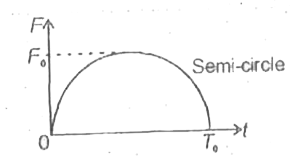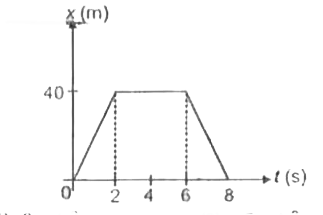The position of a particle moving along X -axis varies with time as x=ut+A sin omega t. Att =0 x=0 . Between t=0 and t=t_(0) average velocity of particle is u .Then values of t_(0) can be (A) (A)/(u) (B) (pi)/(omega) (C) (2 pi)/(omega)
Step by step video & image solution for The position of a particle moving along X -axis varies with time as x=ut+A sin omega t. Att =0 x=0 . Between t=0 and t=t_(0) average velocity of particle is u .Then values of t_(0) can be (A) (A)/(u) (B) (pi)/(omega) (C) (2 pi)/(omega) by Physics experts to help you in doubts & scoring excellent marks in Class 11 exams.
Similar Questions
The magnitude of force acting on a particle moving along x-axis varies with time (t) as shown in figure. If at t = 0 the velocity of particle is v0, then its velocity at t=T0 will be
 View Solution
View SolutionThe position of a particle moving along x-axis varies eith time t as x=4t−t2+1. Find the time interval(s) during which the particle is moving along positive x-direction.
View Solution
Knowledge Check
- Question 1 - Select One
The position x of particle moving along x-axis varies with time t as x=Asin(ωt) where A and ω are positive constants. The acceleration a of particle varies with its position (x) as
Aa=AxBa=−ω2xCa=AωxDa=ω2xA - Question 2 - Select One
The position (x) of a particle moving along x - axis veries with time (t) as shown in figure. The average acceleration of particle in time interval t = 0 to t = 8 s is
 A3m/s2B−5m/s2C−4m/s2D2.5m/s2
A3m/s2B−5m/s2C−4m/s2D2.5m/s2 - Question 3 - Select One
Position of a particle varies as y=cos2ωt−sin2ωt. It is
Aharmonic but not SHMBSHM with period (πω)CSHM with period (2πω)Dperiodic with period (πω) but not SHM.
Velocity (in m/s) of a particle moving along x-axis varies with time as, v=(10+5t−t2) At time t=0,x=0. Find
(a) acceleration of particle at t=2s and
(b) x-coordinate of particle at t=3sView SolutionFor a particle performing liner SHM, displacement varies with time as x=7sin(ωt)+24cos(ωt) Amplitude of oscillation of particle is
View SolutionIf the velocity of a particle moving along x-axis is given as v=(3t2−2t) and t=0, x=0 then calculate position of the particle at t=2sec.
View SolutionA particle is moving on a circular path of radius R with uniform angular speed ω. The magnitude of average velocityof particle during time t=0 to t=2π3ω:
View SolutionThe position vector of a particle is r=asinωtˆi+acosωtˆj
The velocity of the particle isView Solution
